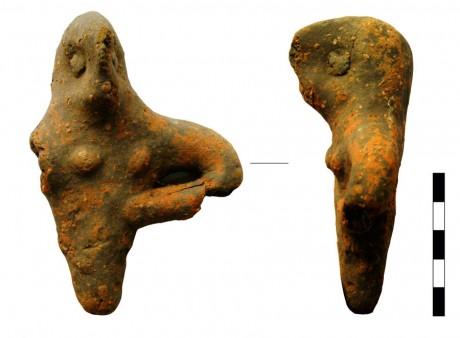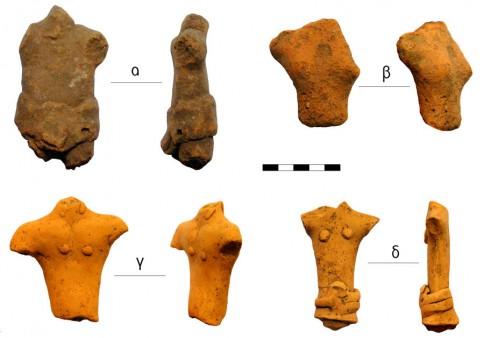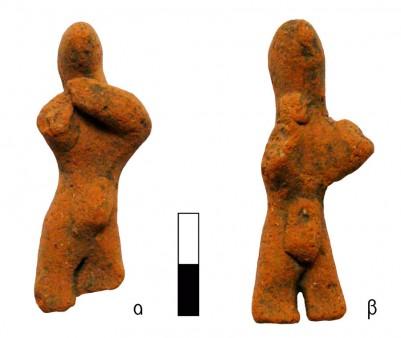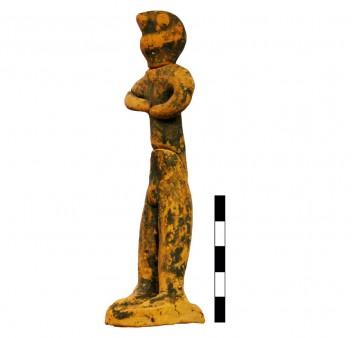Dimitris Sfakianakis / University of Crete
Source - http://www.archaeology.wiki/blog/2015/01/26/systematic-excavation-peak-sanctuary-vrysinas/
As one of the most representative types of assemblage found at every Minoan mountain-edge sanctuary, an impressive number of clay human figurines was discovered on the peak of Agio Pneuma on Vrysinas. These figurines, together with the even larger mass of figurines representing animals, mostly bovids, place Vrysinas among the most important archaeological sites with regard to image-making in clay. For practical reasons, the fragments of human figurines were separated from the vast mass of other pictorial fragments of the assemblage (K. Davaras excavations 1972-1973), so that they could be studied effectively. The systematic study of this group of human figurines forms the subject of my PhD dissertation in the Department of History and Archaeology of the University of Crete, carried out with the financial assistance of the Panayotis and Effie Michelis Foundation.
The material is extremely fragmentary. The unique local environmental conditions at the site and the successive disturbances of the thin fills of the mountain peak are responsible for the state in which the fragile clay figurines were found. Their mutilation and quantity greatly undermined their determinative archaeological investigation and systematic study. The process of separating them out from the huge number of clay pieces resulting from the 1972-73 excavations produced a total of 2,785 fragments originally identified as belonging to human figurines. According to the statistical analyses, the 695 heads counted are combined with 873 records of upper torsos, demonstrating the dynamics of the plethora of human figurines in the specific sample.
The attempt to group the fragments on the basis of stylistic features – i.e. the volume of individual pieces, the outlines, the proportions of body members – and the identification of practices used for the technical and aesthetic representation of the human body, was one of the greatest challenges facing the study of the whole assemblage. In this attempt, multitudinous manifestations of an inexhaustible expressiveness of plastic art in clay came to light, gradually highlighting aspects of Minoan ceramic narrativity in the rendition of the human form, which extends in a range of variations from the early 2nd to the early 1st millennium BC. Obviously, we assume that there would have been lengthy gaps in this production. However, the survivals and revivals of narrative expressiveness in the hand-moulding of the human form in clay display, variations aside, an impressive cohesion and completeness. The basic axes of the narrative language of “additive” clay-shaping (rather than the “abstractive” methods of sculpture), inevitably brings out the makers’ perceptions and image of the human figure, while simultaneously displaying their views on the position of human beings in the specific cultural context.
In three dimensions
The rendition of the human form in three dimensions, especially in malleable clay, reveals both techniques and aesthetic considerations, parameters that preoccupy the potter in his attempt to achieve the fullness of the representation. The perception that two dimensions predominate in the formation of the separate parts of the human body is highlighted by a small group of figurines (fig. 1).

Fig. 1. Human head and upper torso. Vrysinas’s Peak Sanctuary (C. Davaras, exc. 1972-73); S(tudy) N(umber) 1658.
The triangular torso, flattened and without the addition of clay to bulk it out, contrasts with the head, which has been produced by strong pressure stressing the features of the profile. The figurines in this group, which belong to the early potting traditions, reflect corresponding perceptions visible in the Protopalatial two-dimensional anthropomorphic representations, the seals: the frontal triangular torso is combined with a rounded head in profile.
The level of development of the volumes echoes basic characteristics of the perception of the form of the human body. At the same time, it highlights the fluctuations of stylistic processes in the multitude of pottery traditions from Vrysinas. A comparison of some samples shows the level of bulking of the upper torsos.

Fig. 2. Human upper torsos. Vrysinas’s Peak Sanctuary (C. Davaras, exc. 1972-73); α) R(ethymnon) M(useum) N(umber) 2044, β) SN 245, γ) RMN 2012, δ) RMN 22166.
The torso of the male figurine (fig. 2a), which is placed among the early pottery traditions of the group, presents a rigid outline, while it is also heavily flattened. The naturalistic bulking of the female torso, on the other hand (fig. 2b), demonstrates the dynamics of Minoan plastic art in clay. This sample is dated to the early Neopalatial period, a particularly wealthy era for the sanctuary. A similar, though more stylized, bulking is seen in the male torso (fig. 2c) on which the chest muscles stand out, while the nipples are represented by small applied discs. Finally, the elongated, plank-shaped female torso (fig. 2d) demonstrates the evolutionary processes of late pottery traditions at Vrysinas.
The scale
The clay figurines found on Vrysinas are not all of the same size. A rough distinction may be made between the microscopic figurines measuring 4 to 6 cm high, and the sizeable figurines averaging 12 to 15 cm. Obviously the reduction of the human form to the “miniature scale of representation” is connected to the functionality of each figurine, and the process inevitably results in a dilution of their narrative adequacy. Clay figurines, regardless of size, that are detached from their contexts, i.e. their narrative pottery environment, and figurines of all kinds that, still set on their base, potentially retain their “individuality” and autonomy within the pottery assemblage of human forms, are studied together, although their functional nuances – their utilitarian values – appear to differ significantly.
The example of two microscopic male figurines, belonging to a common multi-figure model, gives us a characteristic picture of “miniature narrative” in the anthropomorphic pottery of Vrysinas (fig. 3).

Fig. 3. Miniature human figurines, with the same gesture, wearing belt and codpiece. Vrysinas’s Peak Sanctuary (C. Davaras, exc. 1972-73); α) RMN 16671, β) RMN 16672.
The fabric, the morphological elements such as the applied codpiece, and the distinctive gesture with the left hand touching the right side of the neck while the other is folded towards the chest, the pointed oval head, and the proportions and outlines of the body, are all identical. Moreover, the separate impressions on their short lower limbs and the relative curve on the back of the legs permit us to hypothesise that they were attached to a vertical element of the “scenery”, i.e. the base, of the multi-figure model on which they were set. On the basis of other corresponding examples, the figures were presumably arranged in a circle.

Fig. 4. Standing human figurine, wearing belt and codpiece. Vrysinas’s Peak Sanctuary (C. Davaras, exc. 1972-73); RMN 23674.
The size of the intact figurine in figure 4 corresponds to the average size of the larger figurines in the assemblage. Its functional autonomy is evidenced by the fact that it stands on a square base. However, how far the traditionally recognised “worshiper” of the Minoan peak sanctuaries was a narratively autonomous figurine, among the multitude of other human figures, has been called into question. Despite the particularly rough rendition of the proportions of the body and its individual features, which form part of this particular stylistic tradition, the figurine is complete or even over-abundant in its details. These details are not rendered with plastic elements but by the use of colour, traces of which are preserved on the whole body. The comfortable layout of the various characteristics highlights focuses and suppressions different to those observed on the microscopic figurines.
PART.2